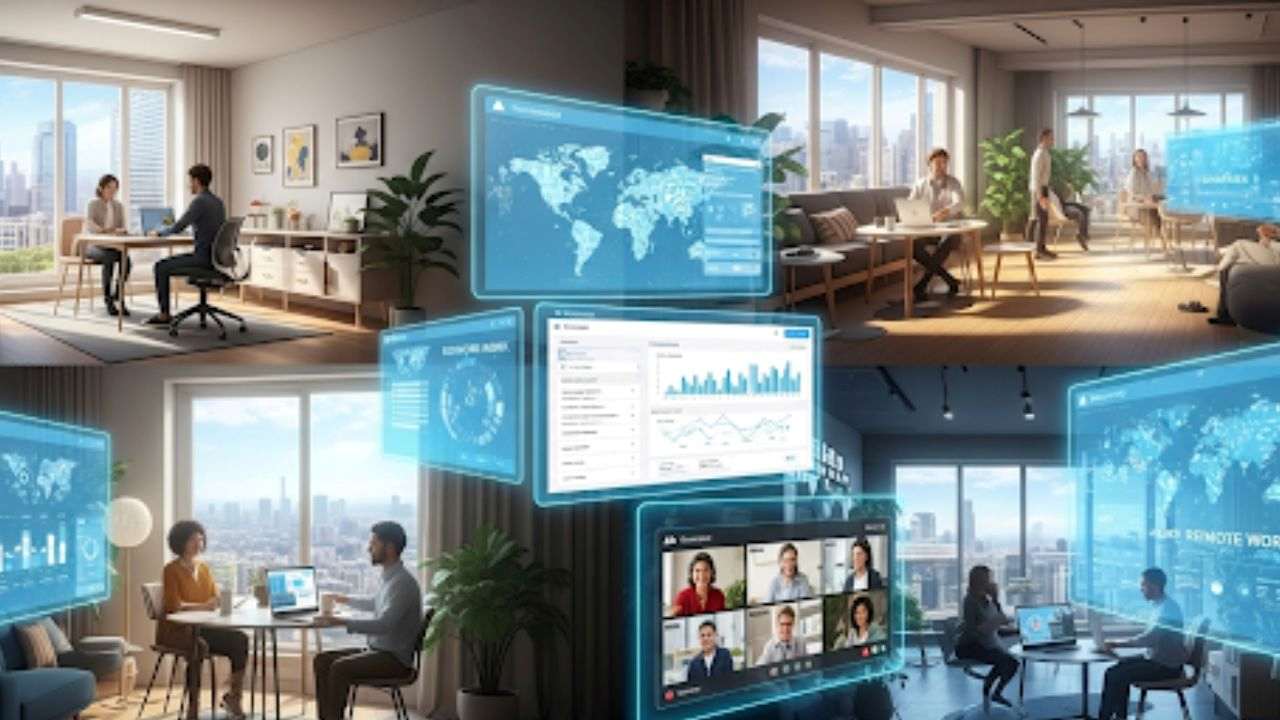In the post-COVID era, digital and remote-first jobs have reshaped the global workforce, with 32% of U.S. workers operating remotely at least part-time in 2025, per a 2024 Gallup survey. Driven by advancements in AI, cloud computing, and asynchronous tools, these roles are transforming industries like healthcare, tech, and education. With 62% of interviews conducted virtually (LinkedIn, 2024) and the global digital workplace market growing at a 22.3% CAGR through 2030 (IndexBox), remote-first work is here to stay. This blog explores key trends in digital and remote-first jobs, their impact, and strategies for professionals to thrive in this evolving landscape.
Key Trends in Digital and Remote-First Jobs
1. Growth of AI-Driven Roles
- What It Is: Roles like AI forecasting specialists and smart grid engineers leverage tools like Azure AI and GPT-5 to optimize workflows, particularly in tech and renewable energy.
- Impact: A 2025 World Economic Forum report projects 12 million new AI-related jobs by 2030, with demand for skills in Python, TensorFlow, and cloud platforms.
- Example: In healthcare, AI specialists develop ambient intelligence systems, reducing patient readmissions by 20% via remote monitoring, per a 2025 HIMSS study.
- Regions: High demand in the EU, U.S., and ASEAN, where AI adoption is surging.
2. Expansion of Cybersecurity Roles
- What It Is: Cybersecurity AI specialists and zero-trust architects protect remote systems, critical as 88% of 2024 healthcare breaches were human-driven (Verizon).
- Impact: Microsoft’s 2024 Cybersecurity for Rural Hospitals Program highlights a 25% reduction in phishing incidents through remote training, driving demand for remote cybersecurity roles.
- Example: Tech firms hire zero-trust specialists to secure cloud-based development pipelines, aligning with NTT DATA’s Microsoft Cloud unit initiatives.
- Regions: Strong growth in the U.S., EU, and China due to rising cyber threats.
3. Asynchronous Collaboration Specialists
- What It Is: Roles focused on managing tools like Slack and Loom to streamline global team workflows, reducing meeting time by 25%, per Gartner 2025.
- Impact: Enables cross-time-zone collaboration, vital for 60% of tech firms operating globally (Gartner).
- Example: Healthcare administrators use Loom to train staff remotely, addressing staffing shortages amid budget cuts.
- Regions: Demand in Asia-Pacific and Europe, where global teams are prevalent.
4. Remote Healthcare and Telehealth Roles
- What It Is: Telehealth nurses, remote patient monitoring specialists, and AI-driven diagnostic roles deliver care via platforms like Zoom and Biofourmis.
- Impact: A 2025 HealthTech Magazine report notes a 20% reduction in readmissions through remote monitoring, critical for rural hospitals.
- Example: Nurses use ambient intelligence to monitor patients remotely, improving access despite $1.2 trillion healthcare cuts.
- Regions: High demand in the U.S., Africa, and India, where healthcare access gaps persist.
5. AR/VR Collaboration Specialists
- What It Is: Experts in platforms like Microsoft Mesh or Spatial design immersive remote meeting spaces, enhancing engagement by 30%, per a 2025 Stanford study.
- Impact: Reduces travel costs by 20% for enterprises, per Deloitte 2025, and supports hybrid training in healthcare and tech.
- Example: Tech teams use VR to prototype designs, speeding iteration by 35% (TechCrunch, 2025).
- Regions: Growing in North America, Europe, and Japan, driven by XR market growth.
Benefits of Digital and Remote-First Jobs
- Flexibility: Asynchronous tools like Slack allow work across time zones, boosting work-life balance for 65% of remote workers (Forbes, 2025).
- Cost Savings: Remote work saves companies $11,000 per employee annually and workers $6,000 on commuting, per a 2024 FlexJobs report.
- Access to Talent: Employers tap global talent pools, critical for healthcare’s staffing shortages and tech’s need for AI expertise.
- Productivity Gains: AI assistants like Microsoft Copilot save 5–7 hours weekly, per Deloitte 2025, enhancing remote efficiency.
- Sustainability: Reduced commuting cuts carbon emissions by 54 million tons annually, per a 2025 Global Workplace Analytics study.
Challenges and Considerations
- Cybersecurity Risks: Remote setups increase attack surfaces, with a 27% rise in ransomware (Verizon, 2024). Zero-trust practices like MFA are essential.
- Digital Disparities: Rural areas face connectivity issues, limiting access to remote healthcare roles, per IRENA 2025.
- Burnout and Isolation: 35% of remote workers report Zoom fatigue (Forbes, 2024), necessitating tools like Loom to reduce synchronous meetings.
- Skill Gaps: Demand for AI and cybersecurity skills outpaces supply, requiring upskilling, per a 2025 World Economic Forum report.
Strategies for Professionals
- Upskill Strategically: Learn Python, Azure, or cybersecurity certifications (e.g., CISSP) via platforms like Coursera, aligning with AI and renewable energy roles.
- Master Asynchronous Tools: Use Slack and Loom proficiently to demonstrate remote collaboration skills, critical for 40% of remote jobs (Gartner).
- Optimize Resumes: Tailor resumes with keywords like “telehealth,” “zero-trust,” or “AI development,” as 75% of employers use ATS (LinkedIn, 2024).
- Leverage Networking: Engage in virtual communities like GitHub or Microsoft’s AI forums to access remote opportunities.
- Prioritize Cybersecurity: Adopt zero-trust practices at home, like MFA and endpoint security, to protect sensitive data, per HealthTech Magazine 2025.
The Future of Remote-First Jobs
By 2030, 50% of global jobs could be remote-first, driven by AI, AR/VR, and 5G advancements, per McKinsey. Healthcare will see telehealth roles expand with ambient intelligence, while tech will prioritize AI-driven development and cybersecurity. Developing regions like ASEAN and Africa will drive demand for remote energy and healthcare roles, addressing digital disparities. Tools like GPT-5 and Microsoft Mesh will further integrate with workflows, enhancing productivity and immersion.



